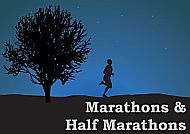Happily the majority of marathon courses are closed to traffic for much of their route – making them safe and generally hassle free places to run.
Apart from a few off road marathons that delight in the difficulty of the terrain runners have to endure, most marathon courses have
- a relatively flat surface to run on
- few sharp corners or steep slopes; and
- most hazards ironed out by experienced organisers and marshals.
This probably won’t be true of the places you do your training.
Tips on finding good places to run.
Find a regular loop of 1-3 miles
Find a regular loop of 1-3 miles
Look at Google Earth or a map to find a route which you can use for runs of multiple lengths, just by varying the number of laps.
Try to avoid
- Crossing the road wherever possible, especially where the traffic is turning from behind you
- Heavy numbers of pedestrians (or numbers of heavy pedestrians if you like)
- Areas where there is no street lighting
- Running in the same direction as the traffic if there is no pavement
- Areas with lots of wet slippery leaves in winter
- Narrow pavements
- Slippery paving stones or cobbles
- Severe cambers, which can put stress on your body
Measuring distances helps
Use Google Earth as a cheap way to find out how far each route is. Write the distance of each route down in miles and kilometers.
You’ll probably become so obsessed with how far you can run in what time that you might want to calculate how many times you would need to run each distance to make up the full 26 miles and 385 yards.
If you’re feeling rich, you can invest in a GPS Sat Nav Running computer. Garmin and other companies sell good wrist GPS devices which also have a heart rate monitor for £50 – 200.
Maybe you’d prefer a pedometer, but they can be fairly inaccurate because they rely on you having an even lenght of stride.
Check out local bus timetables
To add some variety to your running, why not see of there is a bus which can drop you off far from home so you have to run back.
This is good practice for the mental aspect of having to complete a run all the way to the finish line.
Some grass to run on
Sometimes endless running on roads and pavements takes their toll on the body.
Finding a patch of grass you can run on once in a while, especially if you have a few niggles to contend with, is a good bet.
If you are setting targets for training sessions on grass, it might help your self-esteem to remember that grass running is quite a bit slower than running on a hard surface.
Somewhere hilly
There’s a good chance that the race you are preparing for has a hill or two.
You need to find a hilly area to training once in a while otherwise the hilly parts of your marathon will knock the stuffing out of you.
Somewhere for interval training
A good marathon training regime involves plenty of variety, including interval training and Fartlek training.
A lot of runners feel a bit self conscious running around on their own, with arms pumping and sweat pouring out of every pore.
You might want to find somewhere away from the gaze of mocking teenagers to do your interval training.
